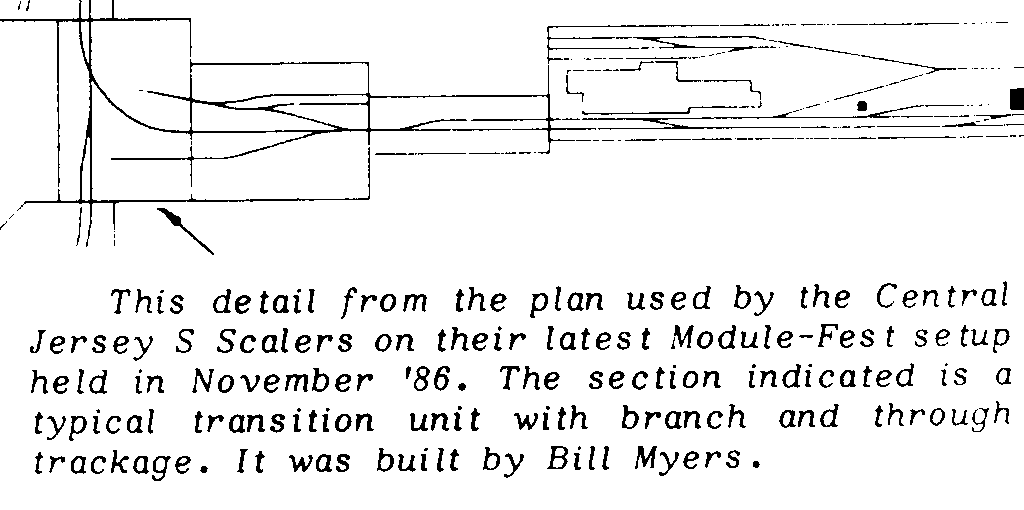This website has been archived from TrainWeb.org/s-trains to TrainWeb.US/s-trains.
The S-Mod System of Module Railroading
By Don Thompson and Don DeWitt
Part 1
Reprints from "The Herald" by permission of author.
Adapted to the WWW by Paul Yorke
| Modules are not a new concept to model railroading.
Many of us learned about them over a decade ago when the Delaware Valley
S Gaugers wrote an article on the subject for this magazine. Many new and
exciting developments have occurred since those first pioneering efforts.
This series, in six installments, will provide the modeler with new guidelines
to use in the design and fabrication of modules that will be compatible
with all others built to THE S-MOD SYSTEM. Let's begin with Chapter 1:
Planning the Module. Modules are intended to be to be versatile. They can be
used for promotional work, club layouts or a way of learning the techniques
used in building model railroads a few feet at a time. The ideal use for
a module is to make it a part of your layout thereby making the fullest
use of the model. Perhaps the first item on your list will be to decide
what purpose the module will serve. Next, consideration should be given to the size of the
module to be planned. How it must be moved, limitations on passageways
and the sheer physical strength needed to lift a large module have a direct
bearing on the final design. Owning a station wagon and having two strapping
sons to move a leviathan module from show to show may be an advantage over
the plight of co-author Don Thompson, whose space is at a premium. Don's
Nissan Sentra will hold two 8' and two 4' modules with the front seat laid
all the way forward, leaving no room for the strapping sons (they are too
young anyway). He has all he can do to lift the larger units and hopes
that someone will be close at hand to help. When planning module size,
the limitations that you may encounter must be considered. Another factor that may influence the size, (especially the length), of the module is the type of layout it will fit into. Modular layouts are much the same as dominos laid end to end. As modules, they can be made into closed systems (loop only), or open (loop to loop, point to loop or point to point). There are advantages as well as disadvantages in either |
system. The loop system is the easiest to
operate. Trains go around and around and require little supervision. It
can become boring rather quickly, however, and at least four corner modules
must be on hand to get the layout running. The open system is more desirable
in that the only restrictions on size are the dimensions of the space available
for set up.
The open system allows prototypical operation in almost
every respect. Junctions, single track mainlines, branches and terminals
may all be assembled in an endless variety of layout schemes to keep the
operating crew on their toes. The disadvantage of this system at shows
or promotion displays is the necessity of having a staff of people who
are willing to operate the layout. A closed/open loop combination system
may be the solution to this problem. A consideration in the design of a module is its length
in relationship to other units that your fellow club members may be building.
If your module is to be included in a closed loop, then you may want to
build in increments of 4', (e.g., 4, 8, 12, etc.). However, any length
may be built as long as there is a corresponding length on the other side.
Liken the scheme to laying sectional track: An odd size or long section
on one side must be balanced with an equal amount of footage on the other.
Another consideration is interchangeability of track design. A double tracked
module will not mate with a single tracked unit without an intervening
section with a switch reducing the line from 2 tracks to 1. While most
modules can be designed as stand alone dioramas, an important fact to consider
is the compatibility of your unit with those of your fellow club members,
or anyone who uses this system. |
Now that you have an idea of the limitations that can be imposed on a module design, lets take a look at the types that can be built:
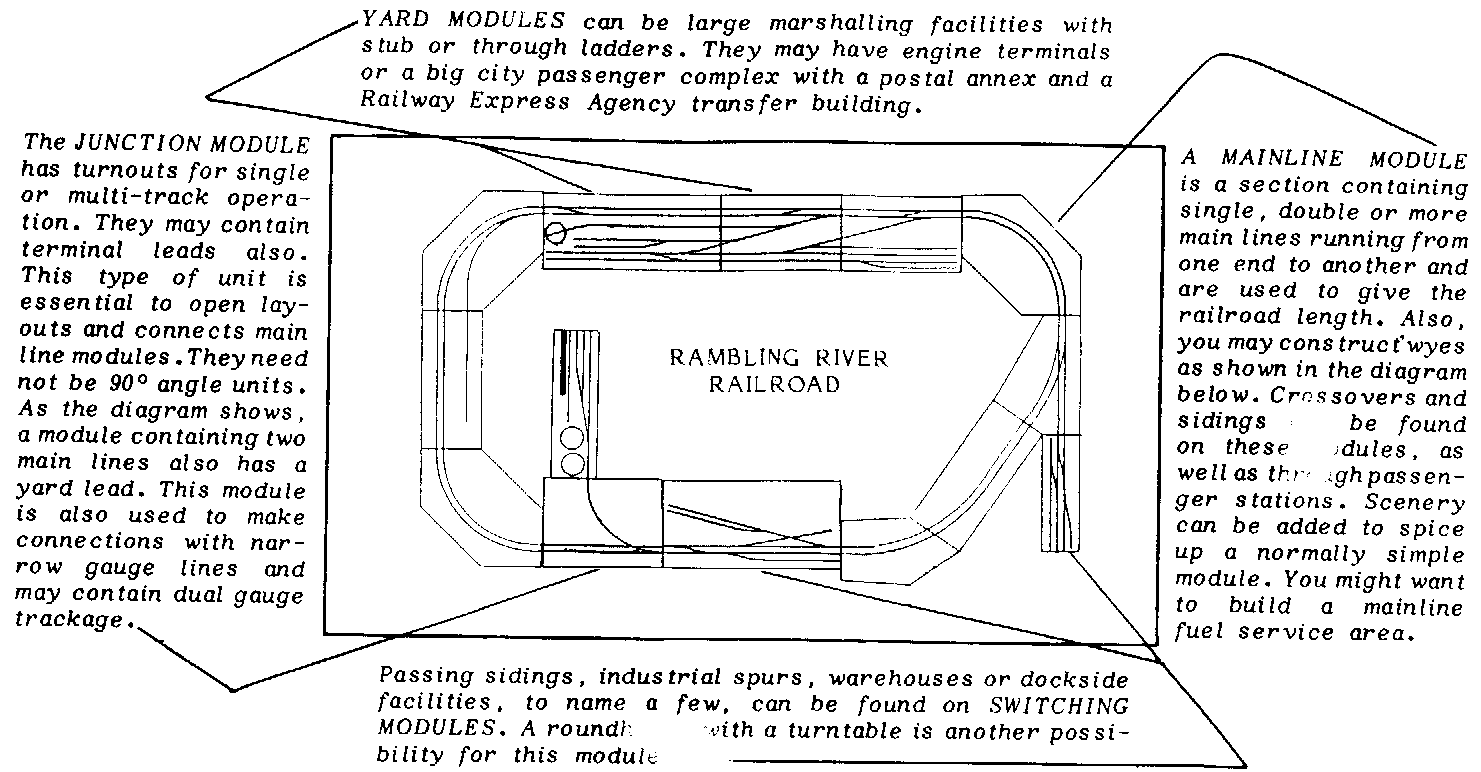
|
As you can see, there are lots of factors that go into designing a module. Here are some examples:
Then you can work your way into a module such as the unit constructed by Stan Stockrocki. He packed the following items into a 3x6' space: A double track mainline flanked by a cement plant, a junk yard, a power plant and a factory amidst two slip switches, two double crossovers and a street railroad. He also found room for a grade crossing!
|
The most popular place on
the layout seems to be the "Y" module. Used as a junction for
three mainlines, this unit affords an excellent spot to train watch, just
like the prototype. Don DeWitt built this module in 3/16" scale. It
is 16' long and 8'deep.
It never ceases to amaze us that
a model railroader will put a locomotive on the rails on a curve. Mike
Ferraro is no exception as he adds his NYC J3 to the modular layout. Kent
Singer, Ed Loizeau and an unknown kibitzer lend a hand. The scene is at
Hoboken Terminal setup in 1986. The variation in module types
is endless. A modeler can build a number of different units with only slight
changes in track plans, but with different industries or scenery. On the
next two pages, a mythical setup shows what can be done with similar modules. |

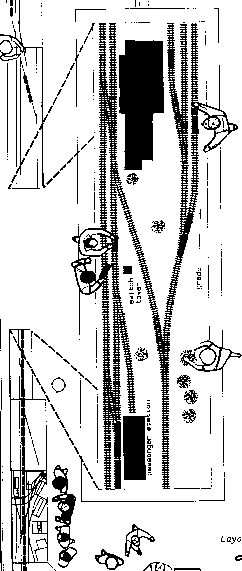 |
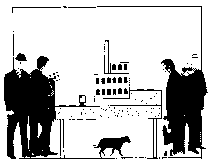
This end view taken from the drawing on thr left depicts the lower level yard which also serves the factory. Modules need not be like straight lines on paper. When Wayne Pier designed the Central Jersey S Scaler's first module, he avoided giving it the "flat look". To accomplish this, he installed a lower level yard and put a slight S curve into one of the mainline tracks. The current owner, Mike Ferraro, moved one crossover and added another, allowing the yard to be worked without fouling the main. As you can see in the detail at the right, a number of operating functions can be built into such a module. The mainline can be either single or double track and sidings appear on both levels. The module has been "shortened" a few feet for this article and is normally 4Xl6'. It also has an interesting history in that it has been to more than 25 shows. |
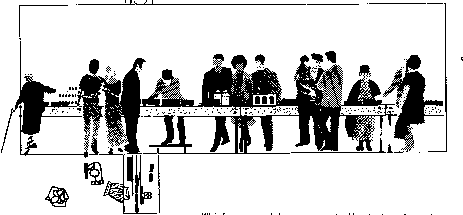
You can be sure to attract a crowd with your module, especially if you adopt the philosophy that if it's interesting to you, it will be the same to others. It is obvious that a well-planned module will last a long time. And
while it is rare that a module will make as many visits as mentioned above,
it can surely be expected to function well with other units built to this
system. The mythical layout running around this page is not as unreal as it may seem. The latest Central Jersey Module Meet held in November 1986 attracted 50+ modules and filled a church hall. This is a good indication that "Module Fever" is catching on and that we will see more such layouts at regional meets in all scales. Incidentally, do not think modules are for scale operators only. Most S Gauge units will accept Flyer and Hi-rail too! Do not hesitate to plan your module just because you're in tinplate. Whichever module you eventually design, bear in mind you will be investing a lot of time, money and effort in its building. Take the time, which costs nothing at this point, to make an effort to design a module that will give you the greatest return on your investment. We recommend that you read a book on the subject by Paul Ingraham entitled "Modular Modeling Manual". It can be obtained direct from the author at 3304 Maybelle Way, #1, Oakland, CA 94619. Your local dealer may have it also. |
 |

Continue to Thompson & DeWitt Part 2











